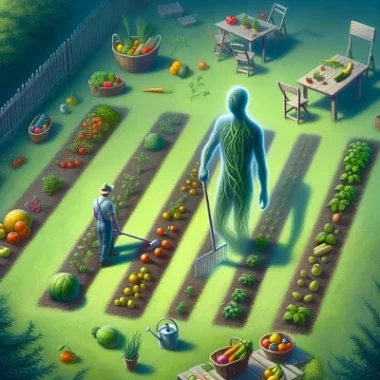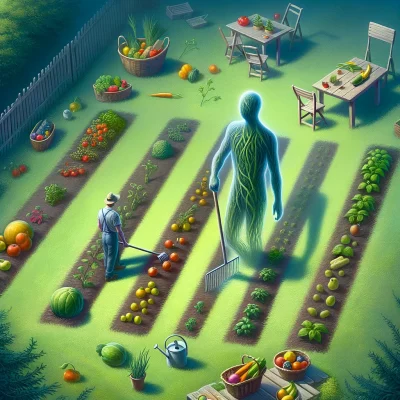
The Invisible Gardener
Defining The Invisible Gardener
The Invisible Gardener is an idea that two people talk about when they can’t agree if something they can’t see is real. Imagine you have a friend who says, “There’s a person taking care of this garden, but we just can’t see him.” You might wonder, “How can that be?” because there is no sign of anyone around. This is the first definition: The Invisible Gardener is a way of thinking about whether we believe in something we can’t see or if we need to see it to believe it.
The second definition relates to deeper thinking. Sometimes in life, we believe in things that don’t have clear proof. Let’s say someone tells you they have an invisible friend who’s really great. You can’t see or touch this friend, so how do you know they’re real? The Invisible Gardener represents this kind of situation where there’s no direct proof of something, but someone believes it exists because they feel it or think it has to be true.
What is The Invisible Gardener?
The Invisible Gardener is a thought experiment used to explore the nature of belief, evidence, and existence. It revolves around a story where two individuals discover a perfect garden and debate the existence of an unseen gardener, leading to various tests to prove or disprove the gardener’s presence. The concept was introduced by philosopher John Wisdom and further developed by Antony Flew, challenging us to question how we determine what’s true in the absence of tangible evidence.
Key Arguments
- The believer’s argument is that the unseen, unfelt, and unheard gardener must exist because the garden’s beauty seems to require a caretaker. This is an example of faith, where someone believes despite a lack of physical evidence.
- The skeptic’s argument is that the absence of evidence from their tests means there is no gardener. They think the garden could be self-maintaining, which shows a need for physical proof.
- The point about unprovable existence suggests that just because you can’t prove something isn’t there, it doesn’t mean it is, posing questions about the limits of knowledge and belief.
- The skeptic’s challenge questions the meaningfulness of claims about things that leave no observable evidence, probing the difference between an undetectable presence and nothing at all.
Answer or Resolution (if any)
There is no definitive answer to The Invisible Gardener, as it serves as a mental puzzle to reflect on belief and evidence. It depends on an individual’s perspective: whether they need concrete evidence to accept something as true or are comfortable believing in the absence of such proof. The thought experiment doesn’t tell us who is right, but encourages us to think critically about our own beliefs.
Major Criticism
One critique of The Invisible Gardener is that comparing belief in God to belief in an invisible gardener doesn’t capture the depth of religious faith, which may include personal experiences and historical context that the simple story omits. Another critique involves “falsifiability”, criticizing the assumption that if we can’t prove something false, it could be true, when in reality, falsifiability is a principle that demands testable evidence to support claims.
Examples and Explaining Their Relevance
- Kindness: Witnessing acts of kindness might be attributed to the invisible concept of “kindness” by believers. Skeptics might argue there is no such thing, suggesting self-interest or instinct are the real reasons behind kind behavior. The relevance here lies in understanding how abstract concepts are accepted or rejected based on belief and skepticism.
- Dark Matter: In astronomy, the existence of dark matter is debated. Some believe in its existence due to the gravitational effects we see in the universe, whereas skeptics demand direct evidence. This is relevant because it highlights how scientific theories are often built on unseen phenomena.
Why is it Important?
The Invisible Gardener is important because it helps us understand the nature of belief. It’s not just about gardens or gods; it applies to many things in life. For example, we might believe in the concept of fairness without seeing it directly, or we might trust that someone loves us even if they don’t show it in obvious ways.
This thought experiment is crucial because it teaches us to question our assumptions and encourages us to think about how we support our beliefs. It’s important for the average person to grasp this as it helps in making informed decisions and understanding others’ viewpoints. Furthermore, it’s relevant to scientists and researchers, pushing them to continually seek evidence and challenge unproven theories.
Related Topics with Explanations
- Faith vs. Evidence: This discussion focuses on whether we accept something as true based on faith—belief without seeing—or evidence—believing because of direct proof. It’s a key part of many areas in life, like religion, relationships, and science.
- Falsifiability: This is the concept that a claim should be able to be proven wrong if it’s wrong. The Invisible Gardener challenges us to think about whether something is true just because we can’t prove it’s false.
- Epistemology: This is the study of knowledge and how we know what we know. The Invisible Gardener ties into this by asking if we can ever truly know something exists if there’s no evidence.
Conclusion
The Invisible Gardener is a concept that challenges us to think about the evidence we need to believe in something. It’s not just about arguing over a hidden gardener; it’s about understanding how we decide what’s true in all areas of life. In the end, whether it’s about spirituality, emotions, or scientific theories, the question of belief without evidence versus the need for tangible proof is central to how we navigate our understanding of the world. This thought experiment is an interesting approach to discussing complex topics, calling on everyone to reflect on the reasoning behind their beliefs.
